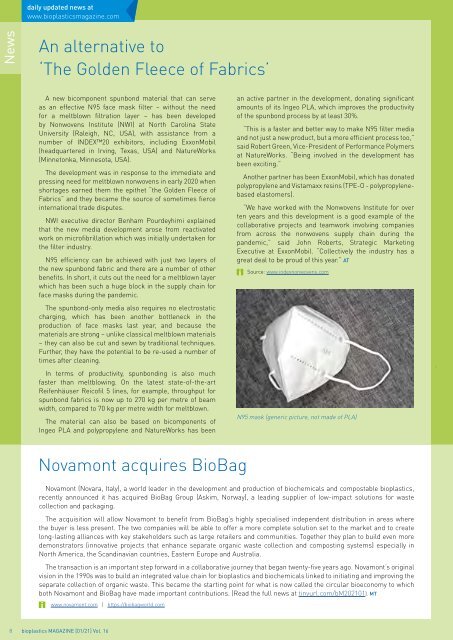Issue 01/2021
Highlights: Automotive Foam Basics: Enzymes
Highlights:
Automotive
Foam
Basics: Enzymes
Create successful ePaper yourself
Turn your PDF publications into a flip-book with our unique Google optimized e-Paper software.
daily updated news at<br />
www.bioplasticsmagazine.com<br />
News<br />
An alternative to<br />
‘The Golden Fleece of Fabrics’<br />
A new bicomponent spunbond material that can serve<br />
as an effective N95 face mask filter – without the need<br />
for a meltblown filtration layer – has been developed<br />
by Nonwovens Institute (NWI) at North Carolina State<br />
University (Raleigh, NC, USA), with assistance from a<br />
number of INDEX20 exhibitors, including ExxonMobil<br />
(headquartered in Irving, Texas, USA) and NatureWorks<br />
(Minnetonka, Minnesota, USA).<br />
The development was in response to the immediate and<br />
pressing need for meltblown nonwovens in early 2020 when<br />
shortages earned them the epithet “the Golden Fleece of<br />
Fabrics” and they became the source of sometimes fierce<br />
international trade disputes.<br />
NWI executive director Benham Pourdeyhimi explained<br />
that the new media development arose from reactivated<br />
work on microfibrillation which was initially undertaken for<br />
the filter industry.<br />
N95 efficiency can be achieved with just two layers of<br />
the new spunbond fabric and there are a number of other<br />
benefits. In short, it cuts out the need for a meltblown layer<br />
which has been such a huge block in the supply chain for<br />
face masks during the pandemic.<br />
The spunbond-only media also requires no electrostatic<br />
charging, which has been another bottleneck in the<br />
production of face masks last year, and because the<br />
materials are strong – unlike classical meltblown materials<br />
– they can also be cut and sewn by traditional techniques.<br />
Further, they have the potential to be re-used a number of<br />
times after cleaning.<br />
In terms of productivity, spunbonding is also much<br />
faster than meltblowing. On the latest state-of-the-art<br />
Reifenhäuser Reicofil 5 lines, for example, throughput for<br />
spunbond fabrics is now up to 270 kg per metre of beam<br />
width, compared to 70 kg per metre width for meltblown.<br />
The material can also be based on bicomponents of<br />
Ingeo PLA and polypropylene and NatureWorks has been<br />
an active partner in the development, donating significant<br />
amounts of its Ingeo PLA, which improves the productivity<br />
of the spunbond process by at least 30%.<br />
“This is a faster and better way to make N95 filter media<br />
and not just a new product, but a more efficient process too,”<br />
said Robert Green, Vice-President of Performance Polymers<br />
at NatureWorks. “Being involved in the development has<br />
been exciting.”<br />
Another partner has been ExxonMobil, which has donated<br />
polypropylene and Vistamaxx resins (TPE-O - polypropylenebased<br />
elastomers).<br />
“We have worked with the Nonwovens Institute for over<br />
ten years and this development is a good example of the<br />
collaborative projects and teamwork involving companies<br />
from across the nonwovens supply chain during the<br />
pandemic,” said John Roberts, Strategic Marketing<br />
Executive at ExxonMobil. “Collectively the industry has a<br />
great deal to be proud of this year.” AT<br />
Source: www.indexnonwovens.com<br />
N95 mask (generic picture, not made of PLA)<br />
Novamont acquires BioBag<br />
Novamont (Novara, Italy), a world leader in the development and production of biochemicals and compostable bioplastics,<br />
recently announced it has acquired BioBag Group (Askim, Norway), a leading supplier of low-impact solutions for waste<br />
collection and packaging.<br />
The acquisition will allow Novamont to benefit from BioBag’s highly specialised independent distribution in areas where<br />
the buyer is less present. The two companies will be able to offer a more complete solution set to the market and to create<br />
long-lasting alliances with key stakeholders such as large retailers and communities. Together they plan to build even more<br />
demonstrators (innovative projects that enhance separate organic waste collection and composting systems) especially in<br />
North America, the Scandinavian countries, Eastern Europe and Australia.<br />
The transaction is an important step forward in a collaborative journey that began twenty-five years ago. Novamont’s original<br />
vision in the 1990s was to build an integrated value chain for bioplastics and biochemicals linked to initiating and improving the<br />
separate collection of organic waste. This became the starting point for what is now called the circular bioeconomy to which<br />
both Novamont and BioBag have made important contributions. (Read the full news at tinyurl.com/bM<strong>2021</strong><strong>01</strong>). MT<br />
www.novamont.com | https://biobagworld.com<br />
8 bioplastics MAGAZINE [<strong>01</strong>/21] Vol. 16


















